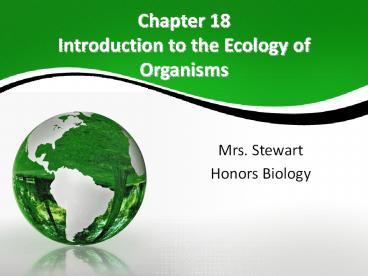Chapter 18 Introduction to the Ecology of Organisms - PowerPoint PPT Presentation
1 / 25
Title:
Chapter 18 Introduction to the Ecology of Organisms
Description:
Chapter 18 Introduction to the Ecology of Organisms Mrs. Stewart Honors Biology Course Level Expectation 3210.2.3 Predict how global climate change, human activity ... – PowerPoint PPT presentation
Number of Views:467
Avg rating:3.0/5.0
Title: Chapter 18 Introduction to the Ecology of Organisms
1
Chapter 18Introduction to the Ecology of
Organisms
- Mrs. Stewart
- Honors Biology
2
Course Level Expectation
- 3210.2.3Predict how global climate change, human
activity, geologic events, and the introduction
of non-native species impact an ecosystem. - Youve learned it if you can
- Predict how a specific environmental change may
lead to the adaptations or extinction of a
particular species.
3
Find a Partner
- One of you is the Tiger (LSU) the other is the
Gator (Florida).
4
Section 1 introduction to ecology
5
Levels of Organization
- Species all the organisms that can/will
interbreed and can produce fertile offspring - Population all members of a species that live
in one place/area - Community all the interacting organisms living
in one place/area - Ecosystem all the organisms and non-living
environment found in one place/area
6
Interdependence
- All organisms interact with all the other living
and nonliving parts of their environment - An environment consists of everything and every
organism in your surroundings
7
Biotic vs. Abiotic
- Biotic
- Abiotic
All the living components of the environment.
All the nonliving components of the environment
such as physical and chemical characteristics.
8
Partner
- Tigers tell your gator the difference between
biotic and abiotic.
9
Partner
- Gators Give your tiger an example of something
biotic and abiotic in this environment.
10
Think pair share Interdependence
- How do autotrophs depend on heterotrophs?
- How do heterotrophs depend on autotrophs?
11
Todays 1st Class Objective
- Explain and draw accurate conclusions from a
tolerance curve graph.
12
Changing Environment
- Change within habitat
- How does an organism survive if environment is
always changing?
Biotic and abiotic factors are always changing.
13
Effects of Interdependence
- Gators Tell your tigers how an organism
survives if the environment is always changing.
14
Tolerance curve
- Every organism has a
of environmental conditions in which it can
tolerate. - Tolerance curve
specific range
A graph of the performance of an organism versus
the value of an environmental variable (usually
abiotic factors).
15
Reading a Tolerance Curve
16
Summarize Tolerance Curve
- Tigers Explain to your gators how to read a
tolerance curve and what implications can be
found.
17
Guided Practice
18
Independent Practice.
- Look at page 364, Figure 18-5 and answer the
following questions on your own. - 1. What swimming speeds do the two fish groups
have? - 2. Would the fish raised at 5C be able to swim
30 cm/s2 immediately after being put in 25C
water? Why or why not?
19
Partner Share
- Compare and discuss your answers with another
tiger or gator near you.
20
Acclimation
- Can a species change its tolerance curve?
- Acclimation
- Example
An organisms change in response to a change in
its environment.
- Altitude sickness
- Barrel Chest
21
Acclimation vs. Adaptation
- Acclimate an individual organisms changes to
surroundings (occurs over short period of time
and could potentially change back if environment
changes back) - Adaptation a populations changes to
surroundings (occurs over very LONG periods of
time)
22
Dealing with internal conditions
- Two ways to deal with varying internal
conditions
Conformers Do not regulate internal conditions.
They must remain in the optimal range of
tolerance to survive.
Regulators Use energy to maintain some of their
internal conditions. They have a wider tolerance
curve for these conditions than do conformers.
An organism can be both!
23
Did We.
- Describe a tolerance graph?
Fish swimming speeds on page 364.
24
Before you leave
- On your Independent Practice paper 1) Predict
what might happen to a bird species that found
itself exposed to unusually cold temps earlier
than normal.2) How might your answer to 1
impact the ecosystem in which the bird lives? - Turn in your Independent Practice page with these
answers when you are finished.
25
Can you?
- 3210.2.3Predict how global climate change, human
activity, geologic events, and the introduction
of non-native species impact an ecosystem. - Youve learned it if you can
- Predict how a specific environmental change may
lead to the adaptation and/or extinction of a
particular species.































